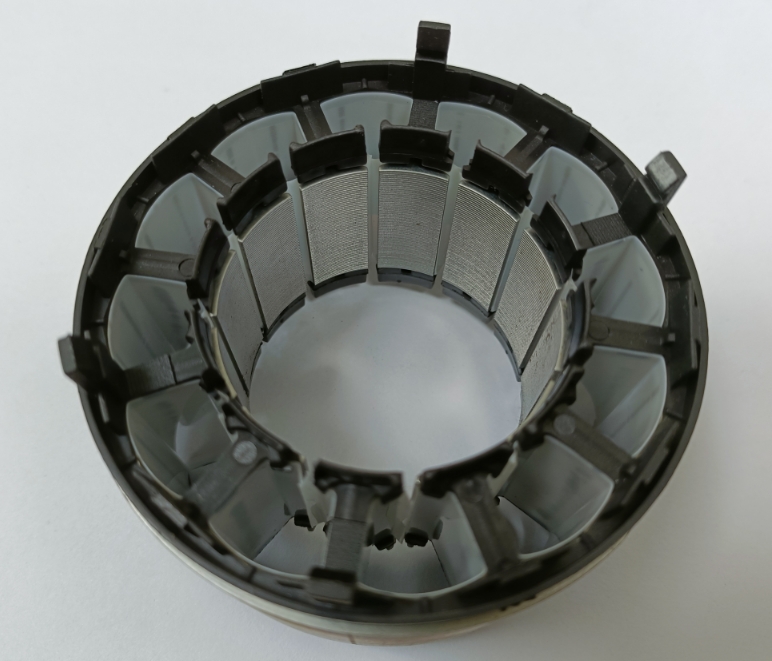How to analyze and troubleshoot the failure of brushless motor motor automatic stator press end plate machine?
Brushless motor motor automatic stator press end plate machine failure, from mechanical, electrical, hydraulic and other aspects of the analysis and troubleshooting, the following is the specific method:
First, the mechanical part
1, insufficient or unstable pressure loading force
Failure analysis: may be insufficient pressure in the hydraulic system, mechanical transmission components wear or loose, poor contact between the press head and the workpiece and other reasons.
Elimination methods: check the pressure value of the hydraulic system, adjusted to the appropriate pressure; check the transmission components such as chains, gears, screws, etc., such as wear or loosening for replacement or fastening; check whether the press head is worn or deformed, such as the problem of timely replacement or repair.
2、Feeding mechanism is not smooth
Failure analysis: may be feeding track blockage, feeding motor failure, drive belt slack or broken, inaccurate positioning device and other reasons.
Troubleshooting: clean up the debris and dust on the feeding track; check whether the feeding motor is running normally, measure the voltage and current of the motor, repair or replace it if there is any abnormality; adjust or replace the driving belt; check the positioning device and readjust the positioning accuracy.
3、Abnormal noise when the equipment is running
Failure analysis: it may be due to serious wear and tear of mechanical parts, bearing damage, loose parts or collision.
Troubleshooting methods: replace the worn parts; replace the damaged bearings; check the connecting bolts and nuts of each part, tighten the loose parts, check whether there is interference or collision between the parts, and adjust them in time.

Second, the electrical part
1、Equipment can not start
Failure analysis: it may be power supply failure, fuse melting, controller failure, motor failure and other reasons.
Troubleshooting methods: check whether the power supply is normal power supply, measure whether the power supply voltage is within the rated range; check whether the fuse is blown, if it is blown, replace the fuse with the same specification; check the working status of the controller to see whether there is a fault alarm code, according to the code to find out the cause of the failure and repair; check the motor windings are short-circuited, disconnected, measure the insulation resistance of the motor, if there is a problem, replace the motor.
2, abnormal motor operation
Failure analysis: may be motor winding failure, drive failure, encoder failure, motor overheating and other reasons.
Troubleshooting methods: use a multimeter and other tools to check the motor winding resistance is balanced, if any abnormalities in the replacement of the motor; check whether the drive parameters are set correctly, whether there is a fault alarm, if there is a problem with the parameter adjustment or repair of the drive; check the encoder connection is not loose, whether there is damage, if there is a problem with the repair or replacement; check the motor's heat dissipation, whether the motor is overloaded, if there is overloading to adjust the load or replace the higher power motor.
3、Control system failure
Failure analysis: may be the controller program error, sensor failure, poor wiring connections and other reasons.
Remedy: reset the controller operation, reload the program; check whether the sensor is working properly, such as proximity sensors, photoelectric sensors, etc., whether there is damage or signal abnormality, replacement or adjustment; check whether the line connection is loose, short-circuit or disconnection, reconnect or repair the line.
Third, the hydraulic part (if there is a hydraulic system)
1, hydraulic oil leakage
Failure Analysis: It may be ruptured oil pipe, aging or damaged seals, hydraulic components wear and other reasons.
Elimination methods: check whether the oil pipe is broken, if broken, replace the oil pipe; replace the aging or damaged seals; check the hydraulic pump, hydraulic cylinder, hydraulic valve and other components, such as wear and tear repair or replacement.
2, the hydraulic system pressure instability
Failure analysis: may be hydraulic oil contamination, hydraulic pump failure, relief valve failure and other reasons.
Elimination methods: replace the hydraulic oil, clean the hydraulic system filter; check the working status of the hydraulic pump, measure the output pressure and flow of the pump, if any abnormalities for repair or replacement; check whether the spool of the relief valve is stuck, whether the spring is damaged, cleaning, repair or replacement.
In fault analysis and troubleshooting, maintenance personnel should have certain professional knowledge and skills, in accordance with the first easy to difficult, first outside the principle of inspection and maintenance. At the same time, maintenance records should be made in order to summarize the experience and improve the maintenance level of the equipment.
※ If the above ways and means still can not solve the equipment failure, please contact Xinhui Electromechanical Equipment Co., Ltd. through the page chat tool to seek help from the technical specialist.







